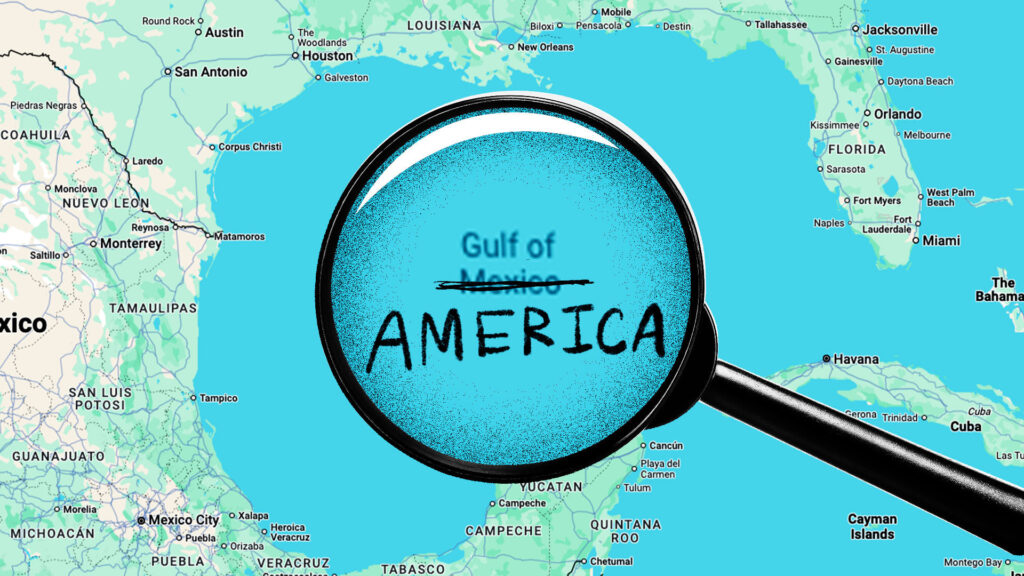Trump’s Gulf of America Rename: A Game-Changer on Google Maps and Beyond

On February 9, 2025, President Donald J. Trump’s executive actions continued to reshape the cultural and political landscape of the United States with the official renaming of the Gulf of Mexico to the Gulf of America. This change, initiated through Executive Order 14172, marks a significant moment in American history, as the Gulf’s new name now reflects a broader, more unified vision of national pride. Not only has this decision captured widespread media attention, but it is also being swiftly implemented on popular platforms like Google Maps and Apple Maps. In this article, we will explore the reasoning behind this name change, the cultural significance, and the global impact of this bold new geographical rebranding.
Why Did Trump Rename the Gulf of Mexico?
The question that many have been asking since the announcement of the Gulf of America is: Why did Trump rename the Gulf of Mexico? This move is part of a larger initiative under President Trump’s administration to restore names that honor American greatness. As stated in the Executive Order, the Gulf of Mexico, long regarded as an integral asset to the United States, has now been rebranded to better reflect the importance of this region to America’s past, present, and future.
The name Gulf of America resonates with a deeper sense of national pride, emphasizing the nation’s history and the strategic importance of the region. For Trump, the Gulf represents more than just a body of water. It embodies a vast area that has historically shaped the development of the country, from its trade routes to its ecological significance. By renaming the Gulf of Mexico, Trump has ensured that the Gulf’s importance is acknowledged in a distinctly American context.
This change isn’t just symbolic; it’s about reinforcing the message that America’s greatness should be celebrated in all aspects of the nation’s identity, including geographical features. The Gulf of America is not only a reference to the territory it covers, but also a symbol of the nation’s expansive reach and heritage.
The Impact on Maps: Google Maps, Apple Maps, and More
One of the most immediate effects of the Gulf of America renaming was the widespread recognition and implementation of the change across maps and digital platforms. Google Maps, one of the most popular mapping tools worldwide, swiftly began displaying the name Gulf of America instead of the old Gulf of Mexico. As part of its longstanding policy of adhering to official government names, Google.maps updated its platform to reflect the Gulf’s new title, ensuring that users could easily locate this rebranded area on the US map.
This change wasn’t just limited to Google Map users in the United States. Maps Google now shows both Gulf of America and Gulf of Mexico, providing clarity for users globally. For those located outside of the U.S., Google Maps ensures that local users will continue to see the name that aligns with their region’s official naming conventions. This dual-naming practice is already in place for other regions, such as the Sea of Japan (East Sea) dispute between Japan and South Korea, where Google Maps ensures both names are visible.
In addition to Google Maps, Apple Maps also joined the change, updating its own systems to reflect the Gulf of America. This means that both major digital mapping platforms now display this revised geographical name, making the Gulf of America a recognizable term for billions of people worldwide.
The Gulf of America: A Symbol of National Pride
The renaming of the Gulf of Mexico is part of a larger national movement under Trump’s administration to assert American dominance in global discourse and reassert the significance of American heritage. The new name, Gulf of America, fits perfectly into this narrative. It serves as a powerful reminder of the U.S.’s rich history and its continuing influence on world affairs.
For Trump, the Gulf is more than just a body of water; it is a national treasure, one that has been integral to the growth of the nation. The Gulf of Mexico has long served as a vital trade route, a source of natural resources, and a strategic military location. By renaming it to the Gulf of America, Trump ensures that the region’s importance is viewed through the lens of American exceptionalism.
Moreover, the renaming fosters a sense of unity within the U.S., reinforcing the idea that America is not just a collection of states, but a unified, singular entity. The Gulf of America reflects the vastness of the country, as it touches multiple states and holds immense importance for the nation’s economy and natural resources.
Reactions to the Name Change: Google Maps Users Weigh In
The response to the Gulf of America name change has been mixed but generally positive. Social media users, especially on platforms like X (formerly known as Twitter), have expressed their approval of the new name, with many praising it for its beauty and significance. Comments such as “Google Maps finally recognizes the Gulf of America! Isn’t it beautiful?” and “I hate Google, but tbh, mine says Gulf of America zoomed all the way out, and boy is it glorious” reflect the enthusiasm with which some have greeted the renaming.
On the other hand, some critics have questioned the necessity of such a drastic change, citing the historical significance of the Gulf of Mexico and wondering whether the renaming is merely a political stunt. However, for many supporters, the new name represents a reclamation of American identity and an affirmation of the nation’s greatness on the global stage.
The Global Perspective: Dual Naming Systems
While the Gulf of America is now the official name used in the United States, Google.maps has employed a dual naming system, showing both names—Gulf of America and Gulf of Mexico—to cater to different regions around the world. This is a common practice for maps, especially when local disputes arise over geographical names. For instance, the Sea of Japan and East Sea dispute between Japan and South Korea has resulted in both names being visible on global maps to avoid alienating either country.
For users in countries outside the U.S., seeing both Gulf of America and Gulf of Mexico ensures that they are aware of the historical and cultural context behind the name change. This system allows Google and other platforms like Apple Maps to maintain accuracy and fairness when dealing with international users while respecting the new name in the United States.
The Future of Geographical Rebranding
The renaming of the Gulf of Mexico to the Gulf of America raises important questions about how future geographical features may be named or renamed in the U.S. As the country continues to evolve, it’s likely that more names will be reconsidered and perhaps rebranded to reflect the nation’s current values and ideals.
For now, the Gulf of America serves as a testament to the bold vision of President Trump and his desire to restore national pride through symbolic actions like this. As the name change continues to take root across digital platforms such as Google Maps, Apple Maps, and even government US maps, the Gulf of America is poised to become an enduring symbol of American identity in the 21st century.
Conclusion
The renaming of the Gulf of Mexico to the Gulf of America is more than just a change in terminology—it’s a redefinition of the country’s identity on the global stage. With Google Maps and Apple Maps adopting the new name, it’s clear that this bold move will have a lasting impact on the way the world views this vital region. Whether you call it the Gulf of America or the Gulf of Mexico, the decision to rename it is a powerful statement about the importance of national pride and historical identity. And for those asking, “Why did Trump rename the Gulf of Mexico?” the answer is simple: to reinforce America’s greatness and ensure that its legacy is reflected in every corner of the nation, even the waters that surround it.



0 Comment